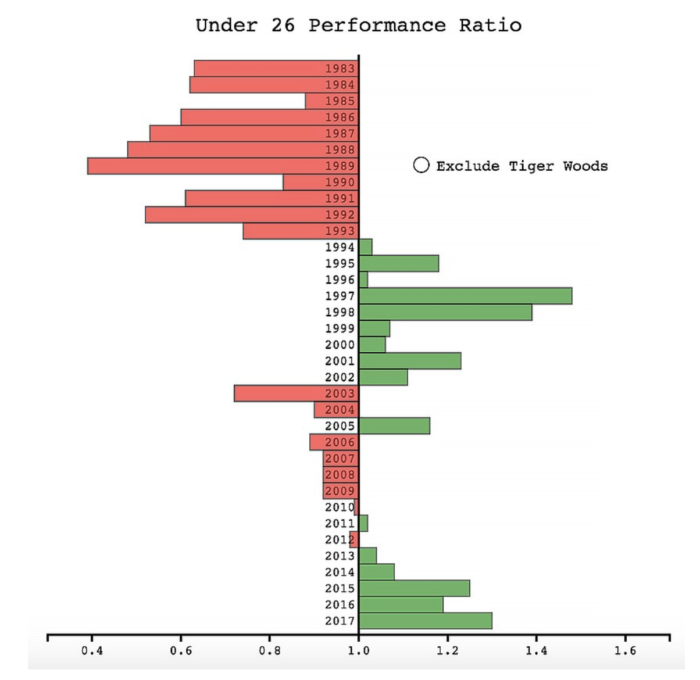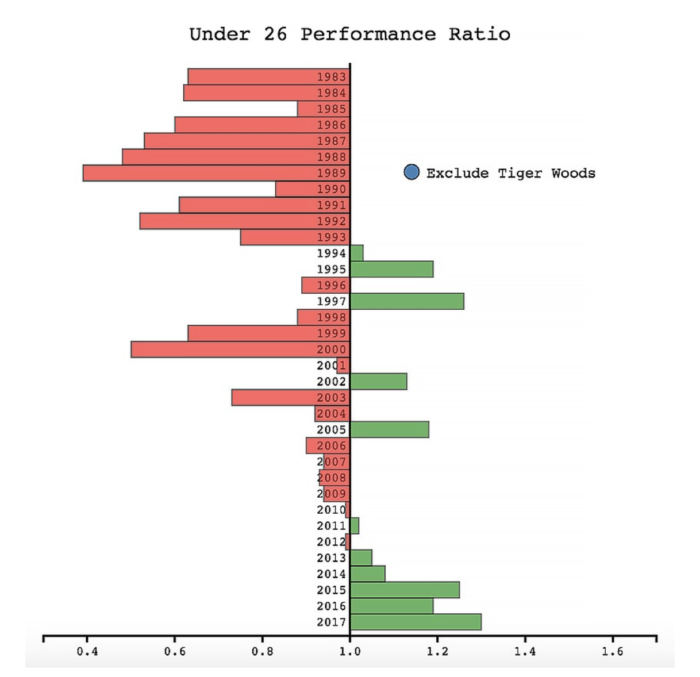Many of us are convinced that the young players coming out of college today are better than ever before. Analysts, fans, and even players have described the recent influx of youngsters as athletic, fearless, and ready to win.
Maybe this is a generation inspired by Tiger; a generation that stayed home from school one week each April to watch Woods maneuver his way around Amen Corner. While it is easy to get mesmerized by the athleticism and distance of these young players, is it true that this generation of young golfers is tangibly better than those that preceded it?
To begin our analysis, let’s look at how young players have performed throughout history. The graph below plots time series of the percentage of wins, top 5s, and top 25s that went to players under the age of 26. It is interactive, so move your mouse around on it.
It appears as though the younger players of recent years are in fact performing better than earlier generations of young players did. Other than the spikes near the year 2000 (Tiger!), the percentages of wins, top 5s, and top 25s going to young players stayed relatively constant between 1983 and 2010. In 2010, we see the beginning of what becomes a steady increase in all three finish types. The red line (percentage of top 25s by young players) is perhaps the most informative, since to move it requires more of a “group” effort (i.e. it can’t be driven by the performances of a single player). By 2015, over 20% of all top 25 finishes were by players under 26, which is higher than it has ever been.
While this result seems convincing, we need to be careful. What if there are simply more young players on Tour than in the past? If the percentage of young players today is greater than the percentage in 2000, holding playing ability constant, we would still expect to see a greater percentage of high finishes by young players today. Let’s explore this further.
The following graph plots the share of starts made by players under the age of 26 on the PGA Tour since 1983.
This plot reveals an inverted hump-shaped evolution in the share of young players on Tour. It helps explain the trends we saw in the first figure. Since the PGA Tour has gotten younger in the most recent decade, it makes sense that we see more young players finishing highly. This also suggests that the young players in the 80s performed very poorly; despite the Tour being quite young at this time, the percentage of high finishes by young players is quite low (see first figure) relative to the percentages today.
To complete the analysis, let’s combine these two pieces of information to fully evaluate the performance of young players on the PGA Tour through the years. Specifically, we want to adjust the percentage of top finishes by young players for the percentage of starts they made up on Tour. To do so, we create a “Performance Ratio”, which divides the percentage of Top 10 finishes going to young players by the percentage of starts made on the PGA Tour by young players. For example, if 10% of all starts on Tour are made by players under the age of 26, and 8% of all Top 10s go to these young players, the Performance Ratio for that year is 8% / 10% = 0.8. A ratio of less than 1 indicates a performance below the level expected given the proportion of players under the age of 26 on Tour, while a ratio above 1 indicates a performance above what would be expected.
Here are the results. We only report the graph for top 10s, although the figure is very similar using top 25s/top 5s. Wins as a measure of performance is too sensitive to an individual performer to provide insight on the talent of a generation of players. It is also worth stating that the results are not sensitive to the specific choice of the cutoff age.


This graph reveals several interesting trends in the performance of young players over time. Firstly, the conclusions drawn from this chart are slightly different than from the earlier figure. While today’s young players are good (Performance Ratio > 1), their ratios are not as high as the young players in some of the years from 1994 to 2002. Second, even though the Tour was very young in the 80s, these players were not performing well, as they registered Performance Ratios well below 1 for 11 years straight.
Since Tiger was so good as a young player, and the Tour was so old while he was younger than 26 (see second figure), he had a strong influence on the Performance Ratio during that era. It is useful to exclude him from the graph to better compare generations across time. By clicking the “Exclude Tiger Woods” button, it reveals how consistent and talented today’s young players are. With a Performance Ratio above 1 for five years in a row, they appear to be performing stronger than any generations in the past.
To conclude, we have seen that the PGA Tour is getting younger, which, unsurprisingly, has led to a larger share of high finishes being captured by young players. Further, even after adjusting for this increase in the proportion of young players, we find that they are consistently recording more than their fair share of high finishes. This is something generations of the past could not do.
So yes, these youngsters are as good as we say they are.

Nice analysis. As you show with the ‘exclude Tiger’ button, a dominant player can really skew the results. The best players tend to capture a larger than average share of top finishes. In the early 80’s Nicklaus, Watson, & Trevino were still quite competitive and then Norman came along and was influential for a number of years, but he broke in after a few years on the Australasian Tour and European Tours so he was already ‘seasoned’ when he started.
I think the mid 90’s also saw many more spots in the field for established older players from the European Tour when the world ranking system was implemented. Might a measure along the lines of ‘average finish by age’ be a stronger comparison across the years? Also the date range covers only two generations so it’s somewhat of a limited view.
I also wonder a bit about the influence of the Golf Channel on younger players coming out with more confidence since they grew up seeing more unedited rounds of pro golf so there was less of a sense conveyed by telecasts or highlight films that they had to perform perfectly to succeed.
Faldo, Price, & Els were big factors in mid 80’s to mid 90’s too. I think it’s quite likely the opening of the tour to top ranked (and likely generally more seasoned / older) international players in the 80’s may have crowded out that era’s crop of younger players. Or was the Euro wave limited primarily to the Majors?
With the Majors, the relative talent at the top seems to matter a bit more. I think since 1986 a player from the Top 10 (rank before the event) would be expected to win just over 50% of the time.